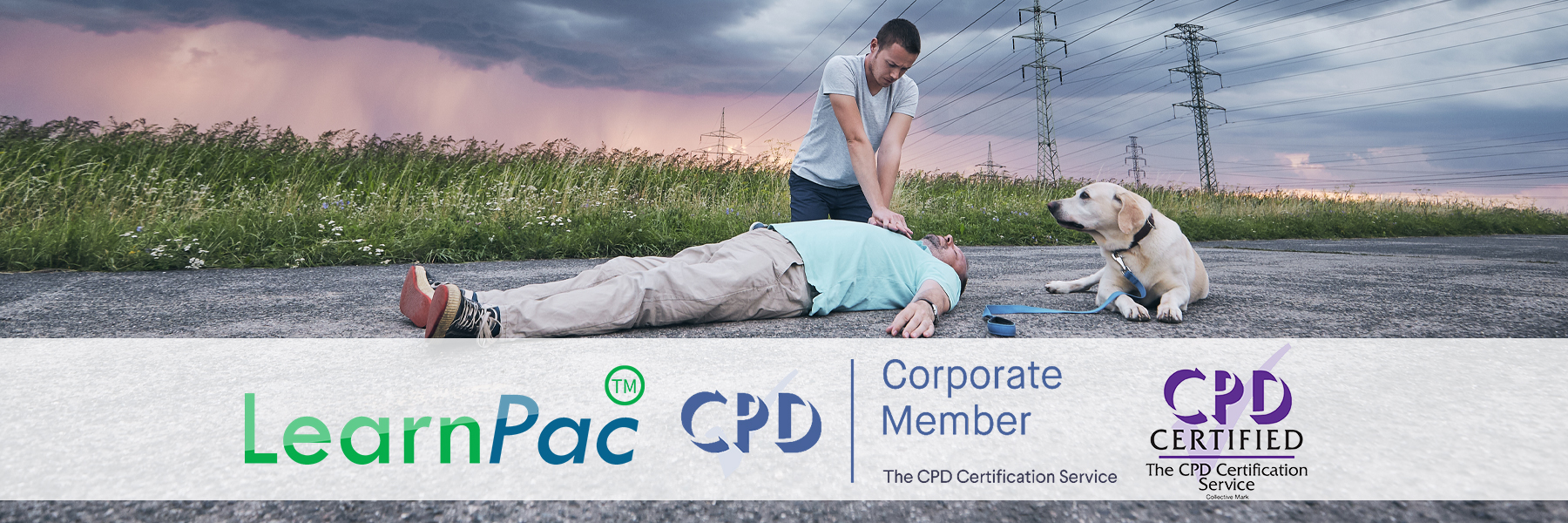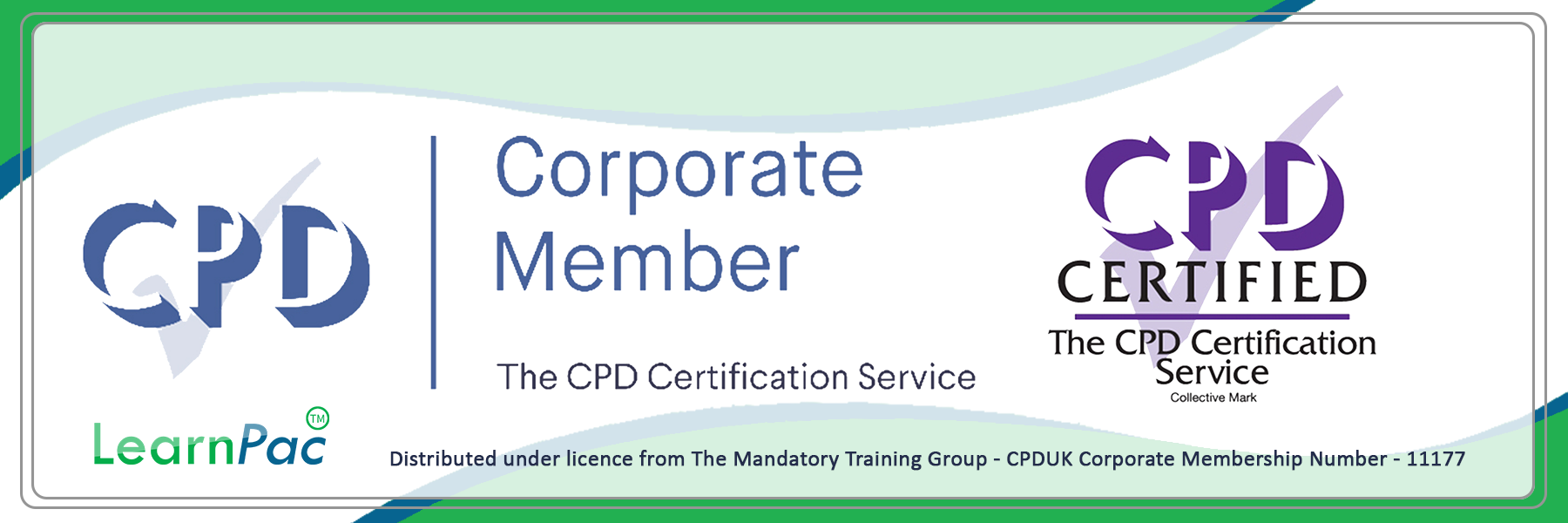Emergency First Aid - E-Learning Courses - CPDUK Accredited

Emergency First Aid – E-Learning Courses with Certificates – CPDUK Accredited.
LearnPac Systems is the leading UK provider of accredited statutory and mandatory training courses for all sectors, including health and social care, education, local government, private and charity sectors.
Emergency first aid eLearning courses helps employees to learn to be more conscious of safety in the workplace, leading to a reduced number of accidents and injuries. Minimising risk to workers and decreasing workplace incidents is a benefit to everyone.
Our emergency first aid e-Learning courses will equip learners with the necessary knowledge and skills to familiarise basic life support, control bleeding and trauma, as well as the proper ways examine a casualty using a defibrillator.
Browse our Emergency First Aid - E-Learning Courses
Emergency First Aid: Frequently Asked Questions and Answers
Emergency First Aid – E-Learning Courses with Certificates – CPDUK Accredited – LearnPac Systems UK.
Here at LearnPac Systems, we receive many questions about emergency first aid. We have provided answers to the most frequently asked questions about emergency first aid.
Click on the text below to see the answers to the Frequently Ask Questions about Emergency First Aid.
The IQL Level 3 Emergency First Aid at Work (EFAW) qualification enables a first aider to give emergency first aid to someone who is injured or becomes ill while at work. This one-day course covers a range of CPR and first aid skills, providing you with the skills to ensure a safe working environment.
LearnPac Systems is the leading UK provider of accredited statutory and mandatory training courses for all sectors, including health and social care, education, local government, private and charity sectors.
Click here for Emergency First Aid at Work – Online Training Course – CPD Accredited
For the one-day emergency first aid at work course, attendees will learn both practical and theory. Through this training, attendees will familiarise basic life support, control bleeding and trauma, as well as how to examine a casualty using a defibrillator.
LearnPac Systems is the leading UK provider of accredited statutory and mandatory training courses for all sectors, including health and social care, education, local government, private and charity sectors.
Click here for First Aid, CPR and AED Training – Online Training Course – CPDUK Accredited
First aid certificates last for three years from their date of issue. However, the HSE recommends that first aiders attend annual refresher training to help maintain necessary skills and to know of any changes to first aid procedures.
You can find either online or in-person courses in most areas. Many local hospitals and community centres offer programs or can point you in the right direction.
The ABC of first aid refers to the primary things that you have to check when you approach the victim. ABC stands for airway, breathing, and circulation. Before administering CPR, ensure that the airway is clear, check to see if the patient is breathing, and check for circulation (pulse or observation of colour and temperature of hands/fingers).
A first aid certificate enables you to assist persons who become injured in the event of an accident or emergency until help arrives. First aid skills can be applied at home, in the workplace and other public locations. Therefore, if there are more first aiders in a community, it becomes safer.
The first aid qualification can be renewed by sitting a refresher course. The Health and Safety (First-Aid) Regulations 1981 require employers to provide adequate and appropriate equipment, facilities and personnel that can administer first aid to employees if they are injured or become ill at work.
These courses generally take about one day, usually around 6 or 7 hours of both theoretical and practical elements. Following such a course, a first aider will deal with major emergencies, such as giving CPR and dealing with people who are choking or bleeding severely.
Here are first aid “must-knows” that you can use to treat a broad array of injuries:
- Check the scene for danger before you provide help.
- To treat cuts and scrapes, apply gentle pressure, disinfectant, and bandages.
- To treat sprains, apply ice and compression at intervals and keep the limb elevated.
- To treat heat exhaustion, use cool fluids, cloths, and shade.
- To treat hypothermia, use warm fluids and covering.
- To treat burns, determine the burn type and severity. Cover the wound with a loose cloth to prevent infection.
- To treat allergic reactions, use an EpiPen.
- To treat fractures, keep the fractured area stable and immobilised. Apply a cold pack.
In the event of an emergency, a fast employee response can save lives. Employees trained in first aid will understand the steps to take during an emergency, thanks to increased confidence and preparation. A quick response can reduce recovery time, leading to less time lost from injuries.
- It can save lives.
- It can reduce the number of workplace accidents.
- It can encourage a positive work environment.
- It can promote a safer place to work.
- It can ensure properly used first aid kits.
- It can reduce recovery time.
- It can keep employees safe outside of the workplace.
- It is a great team-building exercise.
- It gives your employees confidence and clarity during an emergency.
- The cost of first aid at work training course is nothing compared to that of potentially saving a life.
First aid helps ensure that the right methods of administering medical assistance are provided. Knowing how to help a person is just as crucial in emergencies. It only takes six minutes for the human brain to expire due to lack of oxygen.
LearnPac Systems is the leading UK provider of accredited statutory and mandatory training courses for all sectors, including health and social care, education, local government, private and charity sectors.
Click here for Paediatric First Aid – Online Training Course – CPD Accredited
First aid training helps employees to learn to be more conscious of safety in the workplace, leading to a reduced number of accidents and injuries. Minimising risk to workers and decreasing workplace incidents is a benefit to everyone. For employers, it also has implications within all aspects of business operations.
One set of goals of first aid is called the “Three Ps”. The 3 Ps are as follows:
- Preserve life – Stop the person from dying.
- Prevent further injury – Stop the person from being injured. If possible, do not move the injured person.
- Promote recovery – Try to help the person heal their injuries.
Providing students with first aid training helps to reduce risk and empower them with the ability to assess and manage the situation in the event of a medical emergency.
It usually consists of one-time, short-term treatment, such as cleaning minor cuts, treating minor burns, applying bandages, and using non-prescription medicine.
The HSE recommends that if you work in a company with 5-50 workers, there should be at least one person trained in first aid. For low-risk workplaces with 25-50 people, there should be at least one first aider who holds an Emergency First Aid at Work certificate. Moreover, there should be another first aider per 100 employees.
The objectives of this online emergency first aid training course are to:
- Provide essential training resources in a meaningful and engaging way
- Additional eLearning materials that can be used as quick references during the courses and in the workplace
- End of course knowledge assessments that will generate a FREE CPD certificate
- FREE blended learning environment for individuals and organisations.
This online first aid at work training course covers the following:
- The role of the first aider
- First aid kits
- Surveying the scene
- The primary survey
- Resuscitation
- Using an AED
- Unconscious casualty
- Recovery position
- Seizures
- Choking
- Blood loss
- Minor injuries
- Major injuries
- Diabetes.
Burns and scalds are damage to the skin caused by heat. A burn is caused by dry heat, while a scald is caused by something wet. Both are treated in the same way.
Choking occurs when a foreign object lodged in the throat or windpipe, blocking the flow of air. As choking cuts off oxygen to the brain, it is essential to give first aid as quickly as possible.
These are the steps to take in using a defibrillator:
- Step 1: Turn the defibrillator on by pressing the green button and follow its instructions.
- Step 2: Peel off the sticky pads and attach them to the patient’s skin, one on each side of the chest, as shown in the picture on the defibrillator.
- Step 3: If the pads are attached, stop CPR and don’t touch the patient.
Minor bleeding episodes are common, easy to treat, and have no long-term consequence. Major bleeding can be very dangerous and can occur in many situations, even underwater or in the wilderness. Furthermore, accidental cuts, lacerations, or puncture wounds from sharp objects could cause extensive bleeding.
The role of a first aider is to provide immediate, lifesaving, medical care before the arrival of further medical help. It includes placing an unconscious casualty into the recovery position and performing cardiopulmonary resuscitation (CPR).
A seizure is a sudden, uncontrolled electrical disturbance in the brain. It can cause changes in your behaviour, movements or feelings, and in levels of consciousness. If you have two or more seizures or a tendency to have recurrent seizures, you have epilepsy. There are many types of seizures, which range in severity.
Shock is a life-threatening condition that occurs when the body is not getting enough blood flow. Lack of blood flow means the cells and organs do not get enough oxygen and nutrients to function correctly. As a result, many organs can be damaged.
When a person is unresponsive, their muscles relax. Thus, their tongue can block their airway so they can no longer breathe. Tilting their head back opens the airway by pulling the tongue forward. If they are not breathing, their chest and stomach will not be moving, and you will not hear or feel their breaths.
“First aid” is a catch-all phrase that refers to two distinctly different medical needs. Emergency first aid is precisely the first response to a life-threatening (or limb-threatening) medical emergency, either an illness or an injury. It is often called first responder training.
LearnPac Systems is the leading UK provider of accredited statutory and mandatory training courses for all sectors, including health and social care, education, local government, private and charity sectors.
On successful completion of each of the emergency first aid courses modules, you will be able to download, save and/or print a quality assured continuing professional development (CPD) certificate. Our CPD certificates are recognised internationally and can be used to provide evidence for compliance and audit.
The CPD Certification Service (CPDUK) accredits all of our statutory and mandatory training courses as conforming to universally accepted Continuous Professional Development (CPD) guidelines.
LearnPac Systems is distributed under the licence from The Mandatory Training Group – CPDUK Corporate Memebrship Number – 1117.




